With Spectre, the 24th installment of the long-running James Bond franchise, hitting theaters this November, we’re taking a weekly look back across the entire series and charting its changes across its five decades. This week, we look at the Connery era hitting its hot streak with the classics Goldfinger and Thunderball.
Goldfinger
If the first two James Bond films – Dr. No and From Russia With Love – was the franchise hitting the ground running and getting up to speed, then the next two installments were it settling into its stride and then taking things up a notch or three.
Goldfinger is considered seminal Bond, an understandable regard considering that the film introduces the last iconic elements into the franchise. We have the title song lay out against the opening credit for the first time. And this is the first of the films where gadgets become so prominent that a whole scene towards the beginning of the film is needed to introduce them. In addition to Bond’s gadget-laden attache case being held over from the previous film, Bond gets a handy homing device and his iconic tricked out Aston Martin. (Question – If all the glass is bulletproof, how come the car comes with that rear retractable bullet shield?) Other things we’ll see again in the Bond franchise include the dangers of plane cabins and explosive decompression.
 Cec Linder steps into Jack Lord’s shoes as Bond’s CIA ally Felix Leiter. Jack Lord, who played the role in Dr. No, reportedly wanted a bigger bump in salary and co-billing with Sean Connery, so the producers moved on. Things worked OK for Lord as a few years later he went on to star in the immensely popular TV series Hawaii Five-0. Linder had been originally hired to play the card player whom Auric Goldfinger (Gert Frobe) cheats at the beginning of the film. However, he and Austin Willis, whom the producers had originally hired to play Leiter, switched roles shortly before filming. Unfortunately, this left Leiter looking perhaps a bit too old to be a contemporary of Bond.
Cec Linder steps into Jack Lord’s shoes as Bond’s CIA ally Felix Leiter. Jack Lord, who played the role in Dr. No, reportedly wanted a bigger bump in salary and co-billing with Sean Connery, so the producers moved on. Things worked OK for Lord as a few years later he went on to star in the immensely popular TV series Hawaii Five-0. Linder had been originally hired to play the card player whom Auric Goldfinger (Gert Frobe) cheats at the beginning of the film. However, he and Austin Willis, whom the producers had originally hired to play Leiter, switched roles shortly before filming. Unfortunately, this left Leiter looking perhaps a bit too old to be a contemporary of Bond.
As for the titular villain himself, Frobe (with a vocal dubbing assist from Michael Collins) falls into one of the best that the series would ever offer. His most famously quoted line to 007, “No, Mr. Bond, I expect you to die!”, is delivered with the gleeful relish of a sociopath with the means to get whatever he wants. He is not a SPECTRE agent fulfilling a mission with cold efficiency, he is enjoying his work and that makes him all the more menacing and interesting as a character.
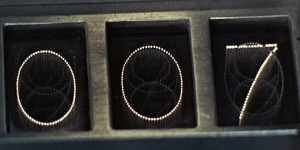 Goldfinger does introduce a rather worrisome trend that we will see repeated off and on over the course of the franchise – someone else saving Bond’s bacon in the nick of time during the film’s climax. In this case, it is a CIA expert turning off the atomic bomb that Bond has found himself handcuffed to deep in the heart of Fort Knox mere seconds – 007 seconds to be precise – before it is set to explode. This won’t be the last time some comes to Bond’s rescue, an action that alternately humanizes him, as it does here, or makes him look a bit like a lucky chump as it does elsewhere.
Goldfinger does introduce a rather worrisome trend that we will see repeated off and on over the course of the franchise – someone else saving Bond’s bacon in the nick of time during the film’s climax. In this case, it is a CIA expert turning off the atomic bomb that Bond has found himself handcuffed to deep in the heart of Fort Knox mere seconds – 007 seconds to be precise – before it is set to explode. This won’t be the last time some comes to Bond’s rescue, an action that alternately humanizes him, as it does here, or makes him look a bit like a lucky chump as it does elsewhere.
The film is also the first one in which a girl who gets mixed up in Bond’s adventure will meet an untimely end. In this case it is the Masterson sisters, Jill and Tilly, both paying the ultimate price for having their paths cross with 007. They won’t be the last.
The opening shot of Goldfinger is a rather spectacular aerial view of Miami Beach that moves in towards one specific luxury hotel just in time to watch a high diver arc off a diving board into the pool. A quick cut to the diver’s entrance to the water from editor Peter Hunt helps set the stage for tricking the audience that most of the scenes that follow were actually shot elsewhere, with Linder being the only of the main cast on location in Florida for shooting. If you watch closely, there are a couple of rear-projection shots that betray the illusion.
Special effects wizard Norman Wanstall would win the franchise its first Academy Award for his work in the film.
Goldfinger does skate a little closer to real world politics than its predecessors. Goldfinger’s operation is being overseen by a mysterious Mr. Ling (Burt Kwouk, who also made his debut as Inspector Clouseau ‘s perennial punching bag in the Pink Panther franchise entry A Shot In The Dark the same year), who has provided the atomic bomb he is going to use to irradiate the gold reserves of Ft. Knox. However, Ling’s “principals” are never directly referred to, leaving us with the impression that they are the Communist Chinese. However, I suppose that there is enough vague wiggle room to allow for the fact that Ling is an agent of SPECTRE. But given that Goldfinger shoots Ling in the chest during the Ft Knox sequence, it is doubtful that he is the same character as the SPECTRE agent Kwouk will play in 1967’s You Only Live Twice.
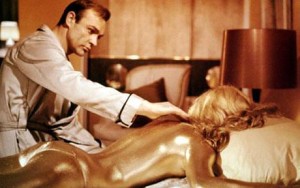 The film is remarkably well paced, and moves along at a clip that makes you ignore such questions as “Given the layout of the hotel room, how does Oddjob get past Jill to clunk Bond unconscious before turning back around to help facilitate Jill’s murder via ‘skin suffocation’ by gold paint?” or “Why when Tilly shoots at Goldfinger does the rifle make the expected loud bang that echoes through the Apls, but Goldfinger and those around him don’t react to the noise though they appear to clearly be within earshot?” And let’s face it, the only reason there is for Goldfinger to tell his plans to a bunch of crime family bosses – look for future Happy Days creator Gary Marshall as one of their number – whom he intends to murder anyway is so Bond can overhear them and discover what Operation: Grandslam is.
The film is remarkably well paced, and moves along at a clip that makes you ignore such questions as “Given the layout of the hotel room, how does Oddjob get past Jill to clunk Bond unconscious before turning back around to help facilitate Jill’s murder via ‘skin suffocation’ by gold paint?” or “Why when Tilly shoots at Goldfinger does the rifle make the expected loud bang that echoes through the Apls, but Goldfinger and those around him don’t react to the noise though they appear to clearly be within earshot?” And let’s face it, the only reason there is for Goldfinger to tell his plans to a bunch of crime family bosses – look for future Happy Days creator Gary Marshall as one of their number – whom he intends to murder anyway is so Bond can overhear them and discover what Operation: Grandslam is.
One thing that should be at least mentioned briefly touched on about Goldfinger is its treatment of women. Granted, for much of the Bond franchise’s existence, women have held one of two roles – objects of sexual conquest for Bond or weapons that can be used against him. But Goldfinger goes a bit far in the scene between Pussy Galore and Bond in the barn. Galore, an overt lesbian in the novel with the movie strongly hinting the same, is forcibly detained by Bond a number of times as she attempts to leave and the final clinch between the two has been interpreted by some as leading to Bond raping the character. Adding to the problematic scene is the fact that it is used as the way Bond gets Galore to defect over to his side, as if he just screwed the evil and lesbianism out of her. Certainly not the most enlightened of positions.
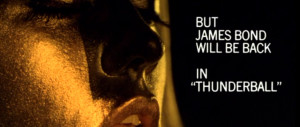 Still, for the criticism it has received, Goldfinger does pass the Bechdel Test, if only just narrowly in the scene where Pussy Galore confers with her all-female pilot squad. And it is only one blemish on an otherwise nearly flawless action film. The franchise itself even addresses the criticisms aimed at it in its next installment.
Still, for the criticism it has received, Goldfinger does pass the Bechdel Test, if only just narrowly in the scene where Pussy Galore confers with her all-female pilot squad. And it is only one blemish on an otherwise nearly flawless action film. The franchise itself even addresses the criticisms aimed at it in its next installment.
Thunderball
Around the middle of Thunderball, James Bond has once again seduced a lovely woman who works for the main bad guy of the picture with the plan to win her over to the side of good and aid him in defeating her former employer. It’s worked before, but not this time. And 007 is given a severe dressing down for his failure – “James Bond, who only has to make love to a woman and she starts to hear heavenly choirs singing. She repents, and immediately returns to the side of right and virtue.” It is as if the film itself were mocking its hero, or at the very least, playing with some of the criticisms that have been leveled at him.
 It is an interesting moment in an already interesting installment in the franchise, if only because it presages the self-awareness that will rise during the Roger Moore era, but without the reflexive jokiness that would, in part, characterize those later films.
It is an interesting moment in an already interesting installment in the franchise, if only because it presages the self-awareness that will rise during the Roger Moore era, but without the reflexive jokiness that would, in part, characterize those later films.
Rick Van Nutter becomes the third actor to portray Bond’s CIA agent friend Felix Leiter in what is becoming a revolving door role for the franchise. He fares little better than his predecessors in terms of importance to the plot. Although he does offer significant help in Bond’s investigation, when it comes time for Bond to lead a group of US Navy SEALS into battle against Largo’s men, Leiter remains curiously out of the action.
 Bond’s old nemesis, SPECTRE, is back, though strangely enough, without an appearance from its leader Blofeld. SPECTRE, Blofeld and the overall plot of Thunderball had originally been developed by Bond literary creator Ian Fleming alongside Kevin McClory and Jack Whittingham for an ultimately aborted James Bond film project being developed before the current franchise launched. Fleming took the material and used it as the basis for his ninth Bond novel, Thunderball, which promptly made him a recipient of a lawsuit from his two former collaborators. An out of court settlement left McClory with certain screen rights, which would be enough to get him a producer’s credit on this film and the justification to try and launch a competing Bond franchise, of which, only Never Say Never Again would actually materialize. These rights issues would come into play again over the franchise’s history. (For those curious as to ins and outs of what would turn into a multiple decades long legal back and forth between McClory and the producers of the Bond franchise, I would recommend Robert Sellers’ meticulous The Battle For Bond.)
Bond’s old nemesis, SPECTRE, is back, though strangely enough, without an appearance from its leader Blofeld. SPECTRE, Blofeld and the overall plot of Thunderball had originally been developed by Bond literary creator Ian Fleming alongside Kevin McClory and Jack Whittingham for an ultimately aborted James Bond film project being developed before the current franchise launched. Fleming took the material and used it as the basis for his ninth Bond novel, Thunderball, which promptly made him a recipient of a lawsuit from his two former collaborators. An out of court settlement left McClory with certain screen rights, which would be enough to get him a producer’s credit on this film and the justification to try and launch a competing Bond franchise, of which, only Never Say Never Again would actually materialize. These rights issues would come into play again over the franchise’s history. (For those curious as to ins and outs of what would turn into a multiple decades long legal back and forth between McClory and the producers of the Bond franchise, I would recommend Robert Sellers’ meticulous The Battle For Bond.)
Also making a return appearance in the franchise is Martine Beswick. First seen in From Russia With Love as one of the two cat-fighting Gypsy women, here Beswick gets a promotion to an intelligence agent assigned to assist Bond in Nassau. Unfortunately, she, too, joins the ranks of women in 007’s life who meet a tragic end, though in her case, that should have been seen as an occupational hazard.
Watching Thunderball in a post-Austin Powers world, it is easy to see where Mike Myers was drawing influence from. Sure, he has stated that his trilogy of spy spoof films were an homage to all of the spy films from the 1960s, but there is so many things drawn specifically from Thunderball, it is hard to imagine that the film was running on a continuous loop in the background while he was writing the screenplay for the first movie. Thunderball opens with a sequence that makes one want to shout “It’s a man, baby!” at the screen before it cycles through eye-patched villains, a meeting of the heads of a terrorist organization in which underlings are punished for failure and sharks. It should be noted that Thunderball‘s sharks lack frickin’ laser beams on their heads as well.
 But setting that aide, Thunderball marks the Bond franchise’s first big epic. The switch in aspect ratios to a wider 2.35:1, a glossier look and Thunderball being the first film in the series to run over two hours all combine for an experience that raises the franchise to another level. The film’s Caribbean locations are used to better effect than they were in Dr. No just a few years earlier and the climactic underwater battle was like nothing seen on the screen before. (Thunderball was later reissued as a double feature with 1962’s Dr. No and I dare say that the franchise’s premier film probably suffered greatly in the side-by-side comparison even though they are separated by just four years.) As for the underwater battle, it was choreographed by none other than the Creature from the Black Lagoon himself, Ricou Browning utilizing a special team of divers whom he has used on other films. John Stears would win the franchise’s second Best Visual Effects Oscar and its last one until 2012’s Skyfall.
But setting that aide, Thunderball marks the Bond franchise’s first big epic. The switch in aspect ratios to a wider 2.35:1, a glossier look and Thunderball being the first film in the series to run over two hours all combine for an experience that raises the franchise to another level. The film’s Caribbean locations are used to better effect than they were in Dr. No just a few years earlier and the climactic underwater battle was like nothing seen on the screen before. (Thunderball was later reissued as a double feature with 1962’s Dr. No and I dare say that the franchise’s premier film probably suffered greatly in the side-by-side comparison even though they are separated by just four years.) As for the underwater battle, it was choreographed by none other than the Creature from the Black Lagoon himself, Ricou Browning utilizing a special team of divers whom he has used on other films. John Stears would win the franchise’s second Best Visual Effects Oscar and its last one until 2012’s Skyfall.
So, how will the Bond franchise top all of this? With ninjas, spaceships and volcano lairs, of course!
Next Up – You Only Live Twice, On Her Majesty’s Secret Service and the franchise’s first change of lead actors.


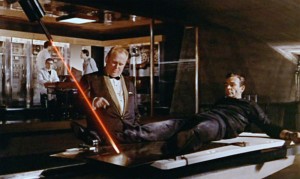



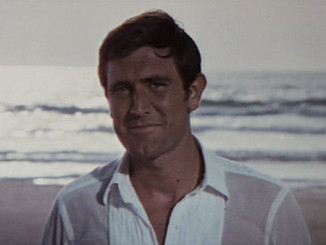
Tom Stroud liked this on Facebook.
Darren Witt liked this on Facebook.
[…] The table was being cut by a bloke with a blowtorch underneath the table, who didn’t really know where Sean Connery… began. The beads of sweat were real in that scene. [Image Credit: Film Buff Online] […]